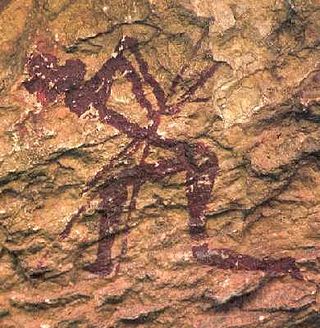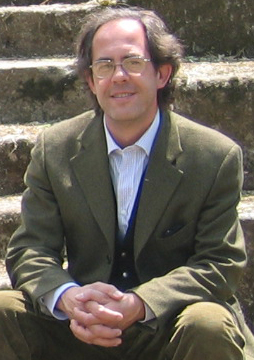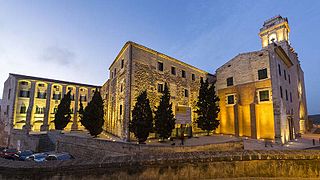
The Archaeological Museum of Asturias is housed in the 16th century Benedictine monastery of Saint Vicente in Oviedo, Asturias, Spain. Its findings include collections of the Asturian Neolithic, Megalithic, Bronze Age, Iron Age, Astur hill fort culture, Roman period, and of the Gothic, Pre-Romanesque and Romanesque periods of the Kingdom of Asturias. The museum also includes sections of Asturian Ethnography, Heraldry, Medieval and Modern Epigraphy, Spanish Numismatics, a European Medal Section, and Armor.

Villena is a city in Spain, in the Valencian Community. It is located at the northwest part of Alicante, and borders to the west with Castilla-La Mancha and Murcia, to the north with the province of Valencia and to the east and south with the province of Alicante. It is the capital of the comarca of the Alto Vinalopó. The municipality has an area of 345.6 km² and a population of 34,928 inhabitants as of INE 2008.

The Archaeology Museum of Catalonia is an archaeological museum with five venues that exposes the most important archaeological collection of Catalonia, focusing on prehistoric times and ancient history. The museum was originally founded in 1932 by the Republican Government of Catalonia. The modern institution was created under the Museums of Catalonia Act in 1990 by the Ministry of Culture of the same Government.
Harold Lewis Dibble was an American Paleolithic archaeologist. His main research concerned the lithic reduction during which he conducted fieldwork in France, Egypt, and Morocco. He was a professor of Anthropology at the University of Pennsylvania and Curator-in-Charge of the European Section of the University of Pennsylvania Museum of Archaeology and Anthropology.
Fereidoun Biglari is an Iranian archaeologist and a museum curator.

Martín Almagro Gorbea is a Spanish prehistorian.

The prehistory in the Valencian Community refers to the period from the Paleolithic, including the appearance of the first populations, until the appearance of colonizing peoples, in the territory of the Valencian Community.

Martín Almagro Basch was a Spanish archaeologist, historian, and writer. He fought in the Spanish Civil War. He was an archaeology specialist, ranging from rock art to classic archaeology. He was a professor of early human history at the University of Madrid and Barcelona, and was Director of the Museo Arqueológico Nacional "MAN" de Madrid between 1968-1981. He directed the first Spanish archeological expedition in Egypt. His contribution in the transfer and rescue of several Egyptians temples was grateful by the Arab Republic with the concession of the Debod temple, actually in Madrid.

Roca dels Bous is an archaeological site located in Sant Llorenç de Montgai, in the Catalan Pyrenees, Spain. Since 1988 the Autonomous University of Barcelona and the UCL Institute of Archaeology study and record the fossil sequence of southern European Neanderthals who inhabited the area during the Middle Paleolithic approximately 50,000 years ago. The excavation team utilizes a worldwide unique digital system and various innovative technologies that significantly improve the quality of the classification of the recovered objects. Roca dels Bous has as one of the first Paleolithic excavation sites in Spain established a visitor centre, that focuses on displaying the Prehistory research of the prepyrenees area.

La Bastida de les Alcusses is an Iberian city of the 4th century BC located near Mogente/Moixent, Valencia. It is considered to be one of the principal Iberian archaeological sites of the Valencian Community due to its sudden abandonment and good preservation. The site is located 741 metres above sea level at the southwest end of the Serra Grossa. The site covers over 4 hectares and is 650 metres long and 150 metres wide. The site is now an archaeological park, surrounded by pine forest and bush but accessible by road.
The archaeological site of Les Raboses is located on the mountain with the same name in the municipality of Albalat dels Tarongers. This deposit is framed chronologically in the Bronze Age.
Helena Bonet Rosado is a Spanish archaeologist who specialises in Iberian material culture. She has published two books and numerous articles and chapters on Iberian archaeology. She is currently the Director of the Prehistory Museum of Valencia.
Pyrenae, Revista de Prehistòria i Antiguitat de la Mediterrània Occidental / Journal of Western Mediterranean Prehistory and Antiquity, is a biannual peer-reviewed academic journal of archaeology published by the Secció de Prehistòria i Arqueologia of the University of Barcelona. The journal focuses a chronological framework that ranges from prehistory to the beginning of the Middle Ages, especially in the Western Mediterranean. The editor-in-chief is Gisela Ripoll.

Furninha, also known as Dominique's cave, is a natural cave on the southern slope of the Peniche peninsula in Portugal. The cave is situated on the cliffs between the Peniche Fortress and the Cape Carvoeiro. The cave is located furthest west of any Neanderthal site. Neanderthals became extinct over 40,000 years ago. The cave was also inhabited by modern humans during the Neolithic.

Xavier Dupré i Raventós was a Spanish archaeologist and historian of classical antiquity. He was the first provincial archaeologist appointed by the archaeological division of the Generalitat de Catalunya in Tarragona. He was also director of Taller–Escola d’Arqueologia de Tarragona (TED’A), director of excavations of the Roman city of Tusculum and deputy director of the Escuela Española de Historia y Arqueología in Rome.

Museo de Menorca is a public institution located in the city of Mahón, Balearic Islands, Spain, which is devoted to the research and diffusion of the prehistory and history of Menorca.
Cova Foradà is an archaeological site consisting of a cave with remains of Neanderthals near Oliva, in the Province of Valencia, Spain. The most complete skeleton of a Neanderthal ever found on the Iberian peninsula was found there in 2010. One of the Neanderthals whose remains were found in the cave used a toothpick to alleviate pain in his teeth caused by periodontal disease and dental wear.

Cueva de Bolomor, or Bolomor Cave, is an archaeological site near Tavernes de la Valldigna in the Valencian Community, Spain. It was occupied over a long period of time, between 350,000 and 120,000 years ago.

Paleolithic in the Iberian peninsula is the longest period of its prehistory, starting c. 1.3 million of years (Ma) ago and ending almost at the same time as Pleistocene, first epoch of Quaternary, c. 11.500 years or 11.5 ka ago. It was a period characterized by climate oscillations between ice ages and small interglacials, producing heavy changes in Iberia's orography. Cultural change within the period is usually described in terms of lithic industry evolution, as described by Grahame Clark.
Miquel Tarradell was an archaeologist and prehistorian, specialist in the Punic, Iberian and Roman world.















